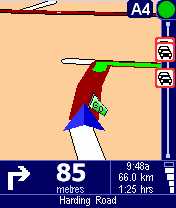Across the board, devices are becoming more and more converged. In 2005, we have phones with PDA functions, cameras and stereo music playback, we have iPods and other music players with basic PIM functions, PDAs with everything except telephony (perversely) and even watches running PIM apps and (in one case) Palm OS.
Where will it all end? Which form factor, which device will dominate? Actually, this one's easy to answer as one form factor already has won. Ask anyone, from a ten year old child upwards, what electronic gadgets they're carrying and you'll always, repeat always, see a mobile phone in the list. In fact, for many people their mobile phone IS now their entire list. The word ubiquitous doesn't even do the mobile phone justice - everybody has one, and I mean everybody. In my own family tree, only those under 8 and over 60 don't carry around a mobile of some description.
So convergence is destined to centre around the mobile phone form factor. Which is bad news for media players, PDAs, digital cameras, watches and just about everything else we might carry around with us. As technology marches on and it becomes possible to cram more and more into a mobile, every other portable device is going to end up a niche product at best.
 Of course, there will always be a place for low-cost, low-functionality handsets, for technically illiterate people who only need a dozen contacts and the ability to receive phone calls. And at least half the market will consist of 'feature phones' doing some of the things described on this page but running a proprietary and inextensible operating system. Above these, and the area where all of us are most interested, is the province of the true, fully extensible, smartphone, currently characterised by Nokia's Series 60 devices, their 9300 and 9500 Communicators, the Sony Ericsson P800/P900/P910 and the Motorola A1000. All of these use Symbian OS, of course, but there's credible competition from Palm OS (the Treo 650) and Window Mobile (various XDA-type devices, plus the large range of keypad-driven 'Windows smartphones').
Of course, there will always be a place for low-cost, low-functionality handsets, for technically illiterate people who only need a dozen contacts and the ability to receive phone calls. And at least half the market will consist of 'feature phones' doing some of the things described on this page but running a proprietary and inextensible operating system. Above these, and the area where all of us are most interested, is the province of the true, fully extensible, smartphone, currently characterised by Nokia's Series 60 devices, their 9300 and 9500 Communicators, the Sony Ericsson P800/P900/P910 and the Motorola A1000. All of these use Symbian OS, of course, but there's credible competition from Palm OS (the Treo 650) and Window Mobile (various XDA-type devices, plus the large range of keypad-driven 'Windows smartphones').
By mid 2006, flash memory cards will be regularly up to 4GB, with room on every smartphone for 50 CD's worth of stereo music, half a dozen movies and all manner of reference applications and games. All smartphones will have megapixel cameras, of course, some even competing with the top standalone digital cameras of today.
It's therefore fairly obvious that the digital camera market is going to shrink dramatically, as is that for standalone PDAs and for music/media players. When Symbian was formed back in the late 1990s, it was hard to see quite where the parties involved were going. In 2005 or 2006, Symbian looks to be on exactly the right track (more or less), with Microsoft (and Windows Mobile) trying to keep abreast of the cutting edge and with Palm not really getting anywhere apart from in its native America.
Each quarter, the Canalys summaries make interesting reading. Nokia's Series 60 smartphones already outsell every other manufacturer and platform's units put together. By quite a margin. Although this gap will close as others (Microsoft especially) pour money into their offerings, the overall smartphone sales figures will grow and grow.
 It's true that many people who currently use a smartphone haven't much of a clue as to which Operating System it runs. They simply know that it's a 'smartphone' because it can play music, take great photos, sync their persnoal data to Outlook and run some games they downloaded from the Web. Maybe that's enough, maybe they don't actually need to know more.
It's true that many people who currently use a smartphone haven't much of a clue as to which Operating System it runs. They simply know that it's a 'smartphone' because it can play music, take great photos, sync their persnoal data to Outlook and run some games they downloaded from the Web. Maybe that's enough, maybe they don't actually need to know more.
But I'm betting that the word will get out and that people will start to expect even more. Having been trialling voice-guided satellite navigation on various smartphones over the last few months (TomTom Mobile 5, Route 66, Wayfinder), I'm convinced that this is one area where even the blinkered general public will start to grasp the advantages of a smartphone that you can extend, that you can load other 'killer' apps onto.
Today's cutting edge of technology is tomorrow's mainstream and uber-smartphones such as the new Nokia N-series are going to be the norm come mid-2006.
Steve Litchfield, 3lib.ukonline.co.uk
